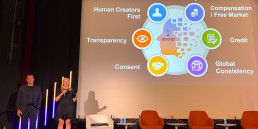How Independent Singers and Music Producers Legally Release Cover Songs: A Step-by-Step Guide
Covering old songs or those originally sung by other artists is a time-honored tradition in the music world. Independent singers and music producers frequently release their interpretations of well-known tracks, either to pay homage to the original or to offer a new twist. However, doing so requires following specific legal procedures to avoid copyright infringement.
This guide will take you through the full process, from licensing to royalties, and every detail in between.
1. Understanding Copyright and Cover Songs
Before diving into the process, it’s important to understand what a cover song is from a legal standpoint. A cover song is a new performance or recording of a song that was originally performed or recorded by another artist. Even though you are performing the song, the copyright for the composition (the melody, lyrics, and structure) remains with the original creators or rights holders (e.g., the songwriter or music publisher).
Copyright owners have the exclusive right to:
- Reproduce the song.
- Distribute copies.
- Perform the song publicly.
- Make derivative works (such as remixes).
- Synchronize it with video content (more on this later).
Thus, to legally release a cover song, you need permission in the form of specific licenses.
2. Obtaining a Mechanical License
A mechanical license grants you the right to reproduce and distribute someone else’s composition in your own recording. This is crucial if you plan to sell or stream your cover.
Why You Need It
- Anytime you sell, stream, or distribute a cover song—whether digitally or on physical formats like CDs or vinyl—you are essentially “copying” the composition, and this is where a mechanical license comes in.
How to Get It
- Harry Fox Agency (HFA): In the U.S., the HFA is a key player in handling mechanical licenses. They manage licenses for millions of songs and streamline the process for cover releases.
- Songfile (by HFA): This service allows you to search for a song and obtain a license for your cover. You simply enter the song details, the number of copies you expect to sell or stream, and pay a fee to secure the license.
- DistroKid: This distribution platform not only releases your music to streaming services like Spotify and Apple Music but also offers a mechanical license service for cover songs. You pay a small fee per cover (around $12 per song per year), and they handle the rest.
- Loudr: This service allows artists to license cover songs easily and distribute them on various platforms.
How Much Does It Cost?
- The cost of obtaining a mechanical license is based on the number of units sold or streamed. As of 2024, the statutory mechanical royalty rate in the U.S. is $0.091 per copy for songs up to five minutes. For songs longer than five minutes, the rate is $0.0175 per minute per copy.
- For streaming platforms, mechanical royalties are paid by the streaming service, but you still need a license.
International Considerations
- If you’re outside the U.S., you’ll need to check with local licensing agencies like PRS for Music in the UK or SOCAN in Canada. These organizations serve the same function as the HFA and help in obtaining the necessary licenses.
- Many services, like DistroKid and Loudr, offer international coverage, which simplifies the process for global releases.
3. Paying Royalties
Once you’ve obtained a mechanical license, you are obligated to pay royalties to the song’s original copyright holders.
How Royalties Work
- Each time you sell a copy (digital or physical) or your song is streamed, you owe a mechanical royalty to the copyright holders.
- In the U.S., the statutory royalty rate is set by the government and is currently $0.091 per song per download or physical sale (up to 5 minutes). This means if you sell 1,000 downloads of your cover song, you owe $91 in royalties to the original songwriters or their publishers.
- For streaming platforms like Spotify, Apple Music, and Amazon Music, royalties are typically handled by the platform, but you still need to have secured the mechanical license.
How Payments Are Made
- When you use platforms like Songfile, DistroKid, or Loudr to obtain the mechanical license, they automatically track your sales and streams, ensuring that the proper royalties are paid to the copyright holder.
4. Sync License for Video Use
If you plan to use your cover in any video content—whether it’s on YouTube, a film, a commercial, or a music video—you’ll need a sync license. This license allows you to synchronize the audio (your cover) with visual content.
Why a Sync License is Needed
- Unlike a mechanical license, which covers audio-only reproductions, a sync license is required anytime a song is paired with video. This includes music videos on YouTube or using the cover in a film or advertisement.
How to Get a Sync License
- Sync licenses are typically negotiated directly with the copyright holder or their music publisher, as there is no standard agency handling sync rights. You can contact the music publisher directly (the publisher’s information can usually be found on the PROs like ASCAP, BMI, or SESAC in the U.S.).
- Sync licensing can be complex and costly, especially for well-known songs. Depending on the use, costs can range from a few hundred to thousands of dollars.
YouTube’s Content ID System
- If you’re only uploading a cover to YouTube, you may not need to obtain a sync license upfront. YouTube’s Content ID system automatically detects copyrighted material, allowing rights holders to claim revenue from your video. In most cases, you won’t earn money from your cover, but the video will remain online, and the copyright holder will earn ad revenue.
- If you wish to monetize your cover, you must negotiate a sync license beforehand.
5. Public Domain Songs
Not all songs require licensing. If a song is in the public domain, you are free to cover, distribute, and even monetize it without needing any licenses.
How to Identify Public Domain Songs
- In the U.S., works published before 1924 are typically in the public domain. This means you can cover and distribute these songs freely.
- Tools like Public Domain Information Project (PDIP) can help you verify whether a song is public domain or not.
International Variations
- Copyright laws vary by country, so songs that are public domain in one country may still be under copyright in another.
6. Derivative Works: Making Significant Changes to the Song
A derivative work involves making significant changes to a song, such as altering the lyrics or changing the melody. Creating a derivative work of a copyrighted song requires explicit permission from the copyright holder, beyond the standard mechanical license.
What Constitutes a Derivative Work?
- Changing the song’s lyrics.
- Modifying its melody.
- Merging multiple songs together into a medley.
- Creating a parody or remix.
How to Get Permission for a Derivative Work
- You will need to contact the song’s publisher directly to get approval for creating a derivative work. This is often a more difficult and expensive process, as the rights holder may deny permission or demand a higher fee.
7. Fair Use
Fair use allows for limited use of copyrighted material without permission in certain circumstances, like for education, criticism, or parody. However, fair use does not generally apply to cover songs.
When Fair Use Applies
- In cases where the song is being used for commentary, news reporting, education, or research, fair use might apply. For example, a teacher analyzing the song in a classroom setting could use fair use as a defense.
- However, simply covering a song in full and distributing it doesn’t usually qualify as fair use.
8. Distribution and Platforms for Releasing Cover Songs
Once you’ve obtained the proper licenses, you’re ready to distribute your cover song. Here’s how to get it onto major platforms:
Digital Distribution Platforms
- DistroKid: Offers both distribution and licensing services for covers, delivering your song to Spotify, Apple Music, Amazon Music, and more.
- CD Baby: Also provides distribution services, but you’ll need to obtain mechanical licenses separately.
- TuneCore: A widely-used platform for distributing music to streaming services and stores. You’ll need to handle mechanical licensing separately.
Streaming Platforms
- Spotify: Requires you to have a mechanical license if you plan to release a cover.
- Apple Music: Similarly, Apple Music requires proper licensing for covers.
YouTube: You can upload covers without a mechanical license under YouTube’s Content ID system, but you may not be able to monetize the video unless you obtain a sync license.
Final Thoughts
Releasing a cover song as an independent artist requires attention to legal details, but by following the correct steps—securing a mechanical license, paying royalties, and potentially obtaining a sync license—you can distribute your music legally and creatively. With platforms like Songfile, Loudr, and DistroKid, the process has become more accessible than ever.
Now, go ahead and share your unique take on your favorite songs



